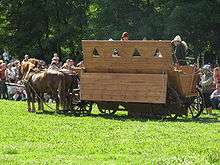War wagon

The war wagon was a medieval innovation that was fully developed by the Hussite Wars around 1420 by Hussite forces rebelling in Bohemia.[1] Devices with a similar function may have existed earlier. For example, the Dongwu Che (Chinese: 洞屋车) was a kind of mobile armoured cart used in Ancient China from the 5th century BC. It was used for the purpose of protecting warriors on the battlefield.
It was a heavy wagon given protective sides with firing slits and heavy firepower from either a cannon or a force of hand-gunners, archers and crossbowmen, supported by infantry using spears, pikes and flails. Groups of them could form defensive works, but they also were used as hardpoints for formations or as firepower in pincer movements.[2] This early use of gunpowder and innovative tactics helped a largely peasant infantry stave off attacks by the Holy Roman Empire larger forces of mounted knights.
After the Hussite wars, they stayed in usage as the special tactical weapon of Bohemian mercenaries which prevailed against knights or foot soldiers. Its successful history came to an end, at least for large scale engagements, with the development of field-piece artillery: a battle wagon wall "fortress" of approximately 300 wagons was broken at the Battle of Wenzenbach September 12, 1504 by the culverines (early canons) and muskets of the landsknecht regiment of G. Frundsberg.
See also
References
External links
- Hussite War-wagons, presenting detailed information about the Hussites' most characteristic tactic, by Matthew Haywood
- General information regarding the Hussite forces
- Google Books The Hussite Wars 1419-36 by Stephen Turnbull
- Hussite Warwagon painting
- Hussite history summary
- Wargaming Hussite armies and tactics